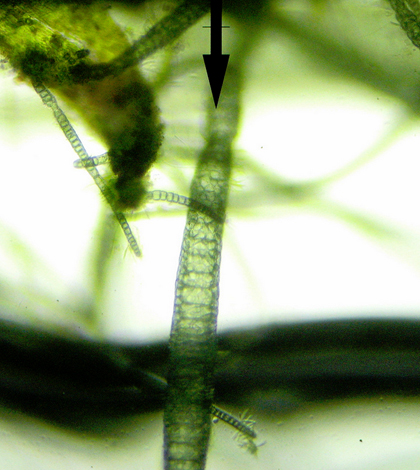Study confirms humans responsible for increased cyanobacteria growth since 1800s

Microscopic view of cyanobacteria in an aquarium. (Credit: Nat Tarbox/CC BY 2.0)
New research from an international team representing Canada, Malaysia, Spain, France and the U.K. confirms and quantifies what ecologists have suspected for years: Human activity is driving cyanobacteria expansion in lakes around the world. The team’s findings were presented in a paper published online in Ecology Letters.
Drawing from sedimentary time series data, as well as records from 18 temperate lakes, the researchers found that cyanobacterial blooms have increased significantly since the beginning of the 19th century. It wasn’t until the end of WWII, however, that their expansion began in earnest.
The paper also suggests that anthropogenic growth in cyanobacteria may set the species apart from other phytoplankton, which don’t seem to have experienced the same boon following the Industrial Revolution.
Phosphorus and nitrogen concentrations are the biggest predictor of cyanobacteria presence in a lake, with temperature also playing an important role. As agricultural operations across the world grow, more fertilizer enters lake systems through rainwater runoff and groundwater seepage. Earlier research has show that cyanobacteria only need a foothold in a lake to begin processes that modify the lake’s nutrient cycle in their favor.

Cyanobacteria form large mat-like colonies that may be toxic to other organisms. (Credit: Rusty Clark/CC BY 2.0)
It’s not just the toxicity of their blooms that make cyanobacteria harmful. When these tiny organisms die en masse, the decomposition of their bodies consumes oxygen in the water. Low levels of dissolved oxygen can stress other aquatic organisms, and limit the habitable space within a lake, leading to increased competition. With enough time, cyanobacteria can totally eliminate oxygen near the bottom of a lake, creating anoxic zones.
The paper notes that, with proper management and limited nutrient uptake, cyanobacterial biomass can be reduced in lakes. But industrial and agricultural practices around the world will have to change if global bloom rates are to stabilize. Until then, remember that we all share a little blame for those inconvenient beach closures in the middle of summer.
Top image: Microscopic view of cyanobacteria in an aquarium. (Credit: Nat Tarbox/CC BY 2.0)





Pingback: Rhode Island, Like Planet, is Turning a Toxic Blue-Green as Climate Changes - ecoRI News